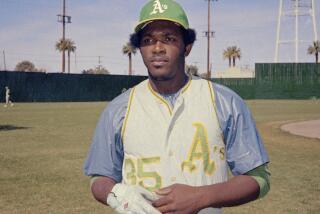Blue Barron, 91; Big-Band Leader Wasn’t One to Jazz Things Up
- Share via
Blue Barron, who led a big-band dance orchestra known for its signature sweet-sounding music, strictly devoid of jazz influences, has died. He was 91.
Barron died in his sleep July 16 at the Baltimore home he shared with his sister, Clarisse B. Mechanic.
“He was a private person. He wanted no publicity. I want to respect his wishes,” Mechanic told the Baltimore Sun.
Fronting a band that played in the style of Guy Lombardo and Sammy Kaye, Barron once had a national audience for his nightly radio broadcasts. He popularized many songs, including the 1948 hit “Cruising Down the River.”
“He was never carried away by his fame, and in its day it was enormous,” veteran New York radio personality Joe Franklin said. “He was the most un-actory, unpretentious, unassuming and untheatrical bandleader I ever had on my programs. He often told me he was more of a businessman and could have been a haberdasher.”
Music colleagues said he was born Harry Freedlin in Cleveland and earned a degree from Ohio University, where he became interested in music management and played violin in a campus band.
“He really played no instruments in the band but was a sharp guy when it came to business,” said Jerome H. “Buzz” Zaremba, a retired drummer who played in the Barron band from 1934 to 1942.
He adopted the professional name Blue Barron and in 1934 founded the Blue Barron Orchestra, directed by Red Atkins.
When Atkins left, Barron began fronting the band. By 1937, Barron had signed an RCA Victor recording contract and had made numerous pressings for its Bluebird label.
His band’s theme song was “Sometimes I’m Happy.” He introduced selections with: “The music of yesterday and today the Blue Barron way.”
“Blue certainly had his own style: highly stylized, an unapologetic, sweet band,” said Rich Conaty, host of “The Big Broadcast,” a New York radio program on Sundays that features popular music of the 1930s.
Conaty said that even though many big bands broke up after World War II, “Blue’s band continued on and had hits well into the 1950s. The critics might have teased his sound, but his music appealed to the feet.”
More to Read
The biggest entertainment stories
Get our big stories about Hollywood, film, television, music, arts, culture and more right in your inbox as soon as they publish.
You may occasionally receive promotional content from the Los Angeles Times.









